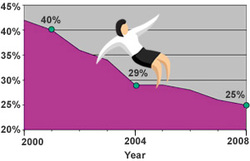Latest Research
where are the girls?

The U.S. Department of Labor estimates that by 2020 there will be more than 1.4 million computing-related job openings. At current rates, however, we can only fill about 30% of those jobs with U.S. computing bachelor's grads. Girls represent a valuable, mostly untapped talent pool.
Girls in IT: The facts (NCWIT, 2012)
Girls in IT: The facts (NCWIT, 2012)
74% of teen girls are interested in STEM, but …

- girls believe that other girls their age aren't considering a career in STEM
- girls are uncomfortable being the only girl in class
- girls believe they would have to work harder than a man to be taken seriously
Generation STEM: What girls say about science, technology, engineering and math (Girls Scouts, 2012)
what’s the problem with girls and computing?

- being passionate about their jobs
- doing interesting work
- having the power to do good and make a difference
- girls feel that computing fails to deliver the three most important characteristics they want from a career:
Site Bibliography
Agosto, D. (2001). Sound, color, and action: Bounded rationality and satisfying in young people's evaluation of World Wide Web resources. Unpublished doctoral dissertation, Rutgers, the State University of New Jersey, New Brunswick.
Agosto, D. (2002a). The prevalence of competition and violence in web-based computer games for youth: A content analysis. Unpublished manuscript.
Agosto, D. (2002b). Toward a model of young people's decision making in the Web. library & Information Science Research, 4, 131.
American Association of University Women. (1999). Gender gaps: Where schools still fail our children. New York: Marlowe.
Cassell, J., & Jenkins, H. (1998). Chess for girls? Feminism and computer games. In J. Cassell & H. Jenkins (Eds.), From Barbie to Mortal Kombat: Gender and computer games (pp. 2-45). Cambridge, MA: MIT.
Claw, J. (2002, April 10). Statistics show fewer women in IT careers. Computer World Canada Online. Retrieved August 24, 2002, from http://www.itworld.com/Career/1832/020410itcareers/pfindex.html.
Comber, C., Colley, A., Hargreaves, & Dorn, L. (1997). The effects of age, gender and computer experience upon computer attitudes. Educational Research, 39, 123-133.
Crawford, K., Groundwater-Smith, S., & Millan, M. (1989). Gender and the evolution of computer literacy. Sydney, Australia: University of Sydney.
Culley, L.(1993).Gender equity and computer in secondary schools: Issues and strategies for teachers. In J. Beynon & H. Mackay (Eds.), Computers into classrooms: More questions than answers (pp. 147-159). London: Falmer Press.
De Jean, J., Upitis, R., Koch, C., & Young, J. (1999). The story of Phoenix Quest: How girls respond to a prototype language and mathematics computer game. Gender and Education, 11, 207-223.
Deitz, T. (1998). An examination of violence and gender role portrayals in video games: Implications for gender socialization and aggressive behavior. Sex Roles, 38, 425-442.
Dorman, S. (1998). Technology and the gender gap. The Journal of School Health, 68, 165-166.
Douglas, C., Dragiewicz, M., Manzano, A., & McMullin, V. (2002). United States: In video games, black women are victims, Latinas don't exist. Off Our Backs, 43 (3/4), 6.
Funk, J., & Buchman, D. (1996). Playing violent video and computer games and adolescent self-concept. Journal of Communication, 46 (2), 19-32.
Galley, C. (1996)., Mediated messages: Gender, class, and cosmos in home video games. In P. Greenfield & R. Cocking (Eds.), Interacting with video (pp. 9-23). Norwood, NJ: Ablex.
Gorriz, C., & Medina, M. (2000). Engaging girls with computers through software games. Communications of the ACM, 43, 42-49.
Giaquinta, J., Bauer, J., & Levin, J. (1993). Beyond technology's promise: An examination of children's educational computing at home. New York: Cambridge University Press.
Heyman, K., & Berstein, J. (1996, November 1). Online games: What girls really want. Netguide, 38.
Inkpen, K., Booth, K., Klawe, M., & Upitis, R. (1995). Playing together beats playing apart, especially for gifts. Proceedings of the Computer-Supported Collaborative Learning Association '95, 1-6.
Inkpen, K., Klawe, M., Lawry, J., Sedighian, K., Leroux, S., & Hsu, D. (1994). "We have never-forgetful flowers in our garden":Girls' responses to electronic games. Journal of Computers in Mathematics and Science Teaching, 13, 383-403.
Jackson, L., Kelly, E., Gardner, P., & Schmitt, N. (2001). Gender and the Internet: Women communicating and men searching. Sex Roles, 44, 363-379.
Kafai, Y. (1996). Gender differences in children's constructions of video games. In P. Greenfield & R. Cocking (Eds.), Interacting with video (pp. 39-66). Norwood, NJ: Ablex.
Kafai, Y. (1998). Video game design by girls and boys: Variability and consistency of gender differences. In .J. Cassell & H. Jenkins (Eds.), From Barbie to Mortal Kombat: Gender and computer games (pp. 90-114). Cambridge, MA: MIT.
Kafai, Y., & Sutton, S. (1999). Elementary school students' computer and Internet use at home: Current trends and issues. Journal of Educational Computing Research, 21, 345-362.
Lawry, J., Inkpen, K., Upitis, R., Klawe, M., Hsu, D., Leroux, S., Anderson, A., Ndunda, M., & Sedighian, K. (1994). Exploring common conceptions about boys and electronic games. Journal of Computers in Mathematics and Science Teaching, 14, 439-460.
Leong, S., & Hawamdeh, S. (1999). Gender and learning attitudes in using Web-based science lessons. Information Research, 5(1). Retrieved August 5, 2002, from: http://Informationr.net/ir/5-1/paper66.html.
Miller, L., Chaika, M., & Groppe, L. (1996). Girls' preferences in software design: Insights from a focus group. Interpersonal Computing and Technology, 4, 27-36. Retrieved August 18, 2002, from http://www.helsinki.fi/science/optek/1996/n2/miller.txt.
Mumtaz, S. (2001). Children's enjoyment and perception of computer use in the home and the school. Computers & Education, 36, 347-362.
Provenzo, E. (1991). Video kids: Making sense of Nintendo. Cambridge, MA: Harvard University Press.
Subrahmanyam, K., & Greenfield, P. (1996). Effect of video game practice on spatial skills in girls and boys. In P. Greenfield & R. Cocking (Eds.), Interacting with video (pp. 95-114). Norwood, NJ: Ablex.
Subrahmanyam, K., & Greenfield, P. (1998). Computer games for girls: What makes them play? In J. Cassell & H. Jenkins (Eds.), From Barbie to Mortal Kombat: Gender and computer games (pp. 46-71). Cambridge, MA: MIT.
Wilder, G., Mackie, D., & Cooper, J. (1985). Gender and computers: Two surveys of computer-related attitudes. Sex Roles, 13, 215-228.
Wilson, B. (2002). A study of factors promoting success in computer science including gender differences. Computer Science Education, 12, 141-164.
Yelland, N., & Lloyd, M. (2001). Virtual kids of the 21st century: Understanding the children in school today. Information Technology in Childhood Education Annual, 175-192.


